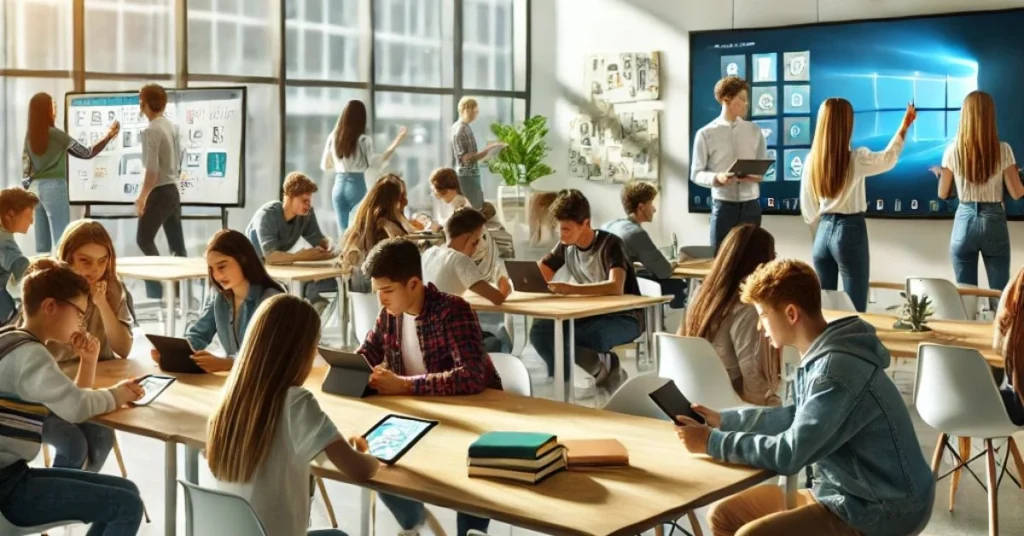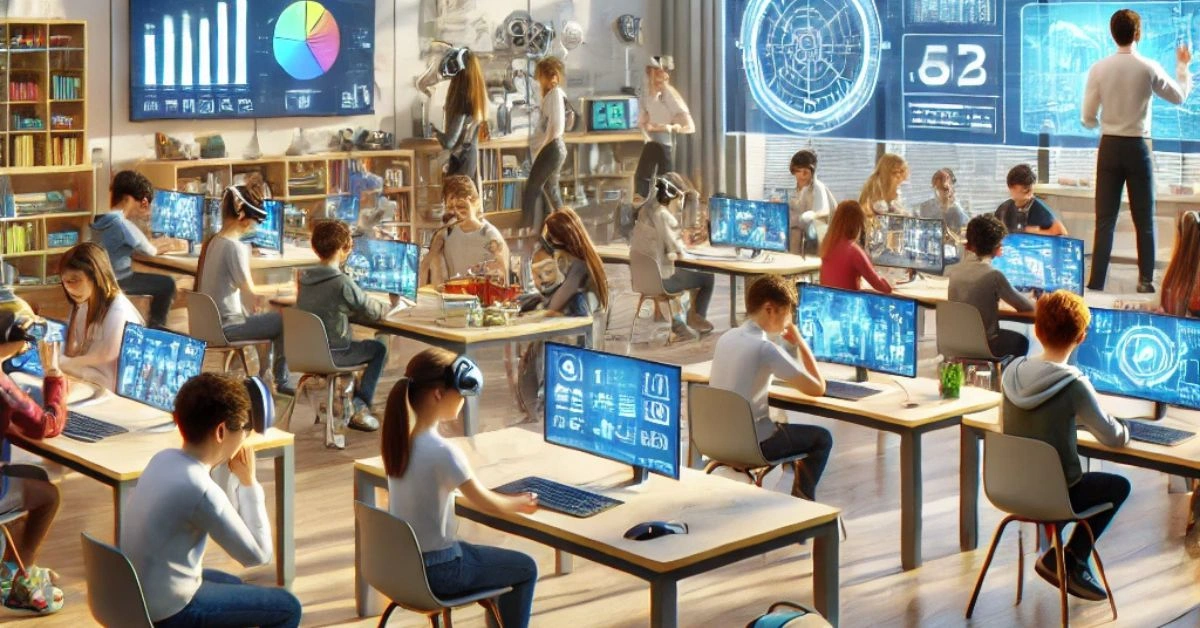Future of the Education Classroom 15x
Classroom 15x: Revolutionizing Education for the Future
Education is evolving, and so are the ways we teach and learn. Traditional classrooms often struggle to meet the needs of modern students. This is where Classroom 15x steps in to revolutionize the learning environment.
Classroom 15x is a concept built around the idea of a “15x multiplier effect.” It focuses on amplifying learning outcomes by 15 times through innovative teaching methods and tools. The goal is to create an environment where students are more engaged, motivated, and empowered to learn.
The idea behind Classroom 15x isn’t just about using technology or new methods. It’s about combining active learning, personalization, and collaboration to make lessons impactful. It ensures that students not only absorb knowledge but also apply it in real-world situations.
Why is this concept important today? Students face increasing demands to be adaptable, creative, and skilled problem solvers. At the same time, educators need practical solutions to overcome the limitations of traditional teaching methods. Classroom 15x bridges this gap by fostering a more dynamic and effective learning process.
This approach also recognizes that every learner is unique. By integrating technology, interactive tools, and hands-on activities, the concept tailors the experience to individual needs. It shifts the focus from passive listening to active participation, making learning more enjoyable and productive.
In this blog, we will explore how this model works, its principles, and the benefits it offers. Whether you’re a teacher, school leader, or education enthusiast, this revolutionary approach has something valuable to offer.
| Aspect | Description | Figures/Examples |
|---|
| Concept | Classroom 15x – A revolutionary education model focusing on a “15x multiplier effect” to amplify learning outcomes. | Goal: Amplify outcomes by 15x. |
| Core Principles | 1. Active Learning 2. Technology Integration 3. Personalization 4. Experiential Learning 5. Collaboration | Focus on engagement, real-world application, individualized learning, and teamwork. |
| Active Learning | Students engage in problem-solving, debates, and group projects instead of passive listening. | Encourages ownership of learning and develops critical thinking. |
| Technology Integration | Utilizes VR, AR, and learning management systems to enhance lessons. | Example: VR virtual field trips or AR simulations. |
| Personalization | Tailors learning to the pace and style of each student, allowing for targeted support and growth. | Adaptive learning technologies track student progress. |
| Experiential Learning | Focuses on hands-on activities that are tied to real-world scenarios to make lessons practical and applicable. | Example: Budgeting for a school event teaches math and teamwork. |
| Collaboration | Promotes teamwork, communication, and problem-solving among students through group projects and collaborative learning. | Students share ideas and learn from one another in a collaborative environment. |
| Benefits for Students | More engagement, improved retention, personalized support, and development of critical skills like problem-solving, creativity, and teamwork. | Increased motivation, higher retention, and confidence in learning. |
| Benefits for Educators | Tools and strategies to improve lesson effectiveness, more rewarding teaching experiences, and professional growth. | Teachers use technology to track student progress and personalize lessons. |
| Benefits for Schools/Communities | Improved student engagement, higher test scores, stronger community connections, and more opportunities for growth. | Improved attendance and performance in schools. |
| Implementation Steps | 1. Assess current strategies 2. Embrace technology 3. Create a culture of collaboration 4. Pilot and scale 5. Measure and iterate | Start small with pilot classrooms, gather feedback, and scale gradually. |
| Technology Tools for Education | Tools like smart boards, VR headsets, interactive whiteboards, and modular furniture that support flexible, engaging learning environments. | Example: Virtual reality headsets for immersive learning experiences. |
| Role of Teachers | Act as facilitators who guide learning, encourage collaboration, and offer personalized feedback. | Teachers use technology and provide ongoing support through adaptive learning techniques. |
| Long-Term Benefits | Enhanced student engagement, better critical thinking and problem-solving abilities, and more confident individuals entering the workforce. | Improved academic performance, stronger workforce readiness, and well-rounded graduates. |
| Examples of Experiential Learning | Hands-on activities like designing budgets, conducting experiments, or solving real-life problems. | Example: A school event budget teaches math, planning, and teamwork simultaneously. |
| FAQ: Role of Collaboration | Students gain diverse perspectives, improve communication skills, and learn teamwork and problem-solving in a supportive environment. | Helps in both academic and real-world settings, fostering positive interpersonal relationships. |
| FAQ: How Schools Implement | Schools can introduce new tools gradually, pilot the model in a few classrooms, and involve the community to enhance collaboration and feedback. | Example: Pilot classroom phase before scaling to more grades. |
The Core Principles of Modern Learning

This approach to learning is built on five key principles that redefine how students learn. Each principle works together to amplify the impact of education. Let’s dive into these principles and see how they transform classrooms.
Active Learning: Making Lessons Engaging
Active learning involves students in the process of learning through activities and discussions. Instead of passively listening to lectures, students engage in problem-solving, debates, or group projects. This hands-on approach makes learning more memorable and exciting.
It also encourages students to take ownership of their education. They build critical thinking skills and develop the ability to tackle real-world problem-solving scenarios. Teachers act as guides, helping students discover solutions on their own.
Integration of Technology: Bringing Learning to Life
Educational technology integration plays a major role in this innovative model. Tools like virtual reality (VR), augmented reality (AR), and learning management systems make lessons more interactive. For example, VR can take students on a virtual field trip to historical landmarks or inside the human body.
These tools cater to different learning styles, helping visual and hands-on learners grasp concepts better. Technology-enhanced learning also allows teachers to track progress and provide personalized feedback. This ensures every student gets the attention they need.
Personalization: Tailoring Learning to Each Student
Not all students learn at the same pace or in the same way. Personalized learning approaches address this by adapting lessons to individual needs. For example, a student struggling with math can work on simpler problems, while others move on to advanced topics.
Teachers can use adaptive learning technologies and data to identify each student’s strengths and weaknesses. Personalization not only helps students improve but also builds their confidence. It ensures that no one gets left behind in the classroom.
Experiential Learning: Connecting Lessons to Real Life
Experiential learning models focus on hands-on activities that relate to real-world scenarios. Students might work on projects, conduct experiments, or solve real-life problems. For example, designing a budget for a school event teaches math and teamwork simultaneously.
This approach helps students see the value of what they’re learning. It bridges the gap between theory and practice, making lessons more meaningful. Students develop skills they can use beyond the classroom, like teamwork and creativity.
Community and Collaboration: Learning Together
Collaborative classroom practices are at the heart of this model. Students work together in teams, share ideas, and learn from one another. This not only boosts their understanding but also improves communication and interpersonal skills.
Teachers also play a key role in fostering a collaborative environment. They encourage open discussions and create a safe space for students to express themselves. By working together, students learn the importance of teamwork and respect for different perspectives.
These principles form the foundation of this innovative approach to education. Together, they create a dynamic and inclusive environment where learning thrives. By focusing on engagement, technology, and collaboration, this model ensures that students are prepared for the challenges of the future.
Benefits for Students and Educators

This new way of teaching doesn’t just change how we teach—it transforms outcomes for everyone involved. Both students and educators benefit greatly from this innovative approach. Let’s explore the key advantages for students, teachers, and even the broader community.
Benefits for Students: More Than Just Grades
Students in this environment are more engaged and motivated. They enjoy lessons because they are active participants rather than passive listeners. This leads to better understanding and longer retention of knowledge.
By focusing on personalized learning, students get the help they need at their own pace. This builds their confidence and helps them excel in areas they previously struggled with. They also develop critical skills like teamwork, creativity, and problem-solving, which are vital for future success.
Students also see the connection between what they learn and the real world. Experiential learning activities make subjects like math, science, and history more practical and meaningful. This prepares them for life beyond school and boosts their overall development.
Benefits for Educators: Teaching Made Easier and Better
This model provides teachers with tools and strategies to make lessons more effective. Technology helps them track student progress and identify who needs extra support. This allows teachers to focus their efforts where they are needed most.
The active and collaborative environment makes teaching more rewarding. Teachers witness their students’ growth firsthand, which adds purpose to their work. This approach also reduces monotony by introducing new, innovative methods that keep lessons fresh and exciting.
Teachers can also grow professionally by learning new skills and adapting to modern teaching practices. They become more confident in using technology and personalizing lessons. This helps them evolve into more effective educators.
Benefits for Schools and Communities: Building Stronger Connections
When students and teachers thrive, schools see improved results. Higher engagement leads to better test scores, attendance rates, and overall performance. This reflects positively on the school and attracts more opportunities for growth.
Parents and the community also benefit from this innovative approach. Students become more confident and well-rounded individuals, which strengthens families and neighborhoods. Schools can collaborate with local organizations to create experiential learning opportunities, further enriching education.
This model is a win-win for everyone involved. Students gain knowledge and life skills, teachers enjoy more fulfilling careers, and schools become centers of innovation. This approach not only improves education but also strengthens the entire community.
Implementing the Model for Transformative Education

Bringing this revolutionary approach to classrooms is a step-by-step process. It requires planning, collaboration, and a willingness to embrace change. Here’s how teachers, schools, and communities can make it happen.
Step 1: Assess Current Teaching Strategies
The first step is to understand what’s already happening in the classroom. Teachers and administrators should evaluate existing teaching methods and identify areas for improvement. This helps set clear goals for implementing a more impactful model.
It’s also important to gather feedback from students and parents. Their input can highlight challenges and opportunities that might not be obvious. By understanding everyone’s needs, schools can create a better learning environment.
Step 2: Embrace Technology and Tools
Schools should invest in tools like smart boards, interactive whiteboards, and virtual reality headsets. These tools make lessons interactive and engaging for students. Modular classroom furniture can also support flexible learning spaces for various activities.
Teachers should be trained to use these technologies effectively. Workshops and professional development sessions can help educators feel confident with new tools. A gradual introduction of technology ensures smooth adoption without overwhelming teachers or students.
Step 3: Create a Culture of Collaboration
Collaboration is at the heart of this model. Teachers should encourage students to work together on projects and assignments. Group activities build teamwork and help students learn from each other.
Parents and the community should also be involved in this process. Schools can organize events, like open houses or workshops, to share the benefits of collaborative learning. When everyone works together, the learning environment becomes more supportive and inclusive.
Step 4: Pilot and Scale the Model
Start small by introducing these principles in one or two classrooms. Use this pilot phase to gather feedback from students and teachers. Identify what works well and what needs improvement.
Once the pilot is successful, scale the model to other classrooms or grade levels. Each phase of expansion should include regular evaluations. This ensures the model is consistently effective and meets the needs of all learners.
Step 5: Measure and Iterate for Success
Measuring the impact of this model is essential. Teachers can use tools like quizzes, projects, and observation to track student progress. Data from these assessments can highlight what’s working and where adjustments are needed.
Feedback from students, teachers, and parents is also valuable. Schools should use this input to refine and improve the learning environment over time. Continuous improvement ensures that the approach remains effective and inspiring.
By following these steps, schools can successfully implement this transformative model. It’s not about overnight change—it’s about making thoughtful, meaningful improvements. With commitment and collaboration, this approach can revolution
Conclusion
The future of education lies in creating dynamic, engaging, and personalized learning environments that foster collaboration, creativity, and critical thinking. By integrating modern teaching methods, technology, and experiential learning, we can ensure that students are not just absorbing knowledge but applying it in meaningful ways. This revolutionary approach to education empowers both students and educators, making learning more impactful and enjoyable.
Educators now have the tools to make lessons more engaging, while students benefit from a personalized, hands-on approach that helps them develop skills they will carry with them into adulthood. Schools and communities also thrive when learning environments are reimagined to encourage growth, collaboration, and innovation. By embracing these principles, we can transform education into a more effective and inclusive experience for everyone involved.
What makes this approach to education different from traditional methods?
This approach focuses on engaging students through active learning, technology integration, personalization, and real-world applications. Unlike traditional methods where students passively absorb information, this model encourages students to take an active role in their learning, making it more dynamic and meaningful.
How does technology enhance the learning experience?
Technology makes learning more interactive and immersive. Tools like virtual reality (VR) or augmented reality (AR) bring lessons to life by providing hands-on, visual learning experiences. Additionally, learning management systems and other tech tools help teachers monitor student progress, personalize lessons, and offer timely feedback.
Is personalized learning suitable for every student?
Yes, personalized learning ensures that each student receives the support they need at their own pace. Whether a student is excelling or struggling in a particular subject, personalized learning helps tailor the content to their specific needs, ensuring no one falls behind.
How does collaboration benefit students?
Collaboration encourages teamwork, communication, and problem-solving—skills that are essential both in school and the real world. By working together, students gain diverse perspectives, learn from each other, and improve their interpersonal skills. This fosters a positive, supportive learning environment.
What role do teachers play in this model?
Teachers act as facilitators and guides rather than traditional lecturers. They support students in discovering answers on their own, encourage collaboration, and provide personalized feedback. Teachers are also responsible for integrating technology and creating an inclusive environment that adapts to the needs of each student.
How can schools start implementing this model?
Schools can begin by assessing their current teaching strategies and gathering feedback from students and parents. Introducing new technologies gradually, creating collaborative learning opportunities, and using pilot programs in select classrooms are all great first steps. The key is to evolve thoughtfully, gathering data along the way to measure success and make necessary adjustments.
What are the long-term benefits of this approach?
Long-term benefits include higher student engagement, improved critical thinking and problem-solving abilities, and a better understanding of real-world applications of academic content. For educators, it leads to a more rewarding teaching experience, as they can see the direct impact of their efforts on student success. The broader community also benefits from more well-rounded, confident individuals entering the workforce.

